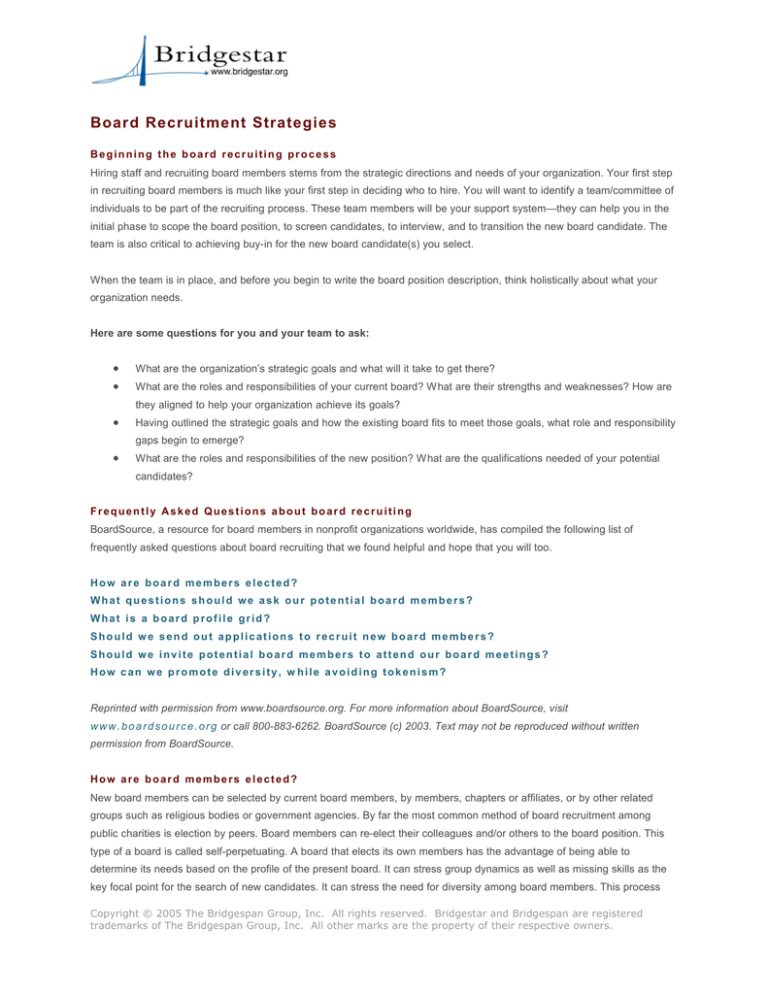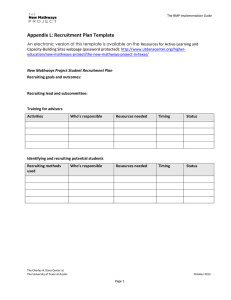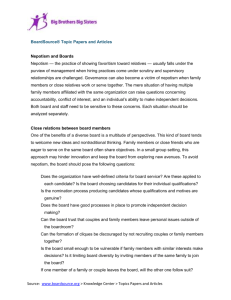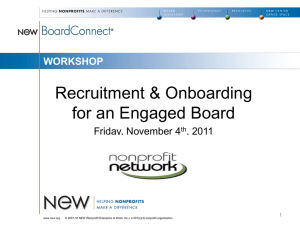Board Recruitment Strategies
advertisement

Board Recruitment Strategies Beginning the board recruiting process Hiring staff and recruiting board members stems from the strategic directions and needs of your organization. Your first step in recruiting board members is much like your first step in deciding who to hire. You will want to identify a team/committee of individuals to be part of the recruiting process. These team members will be your support system—they can help you in the initial phase to scope the board position, to screen candidates, to interview, and to transition the new board candidate. The team is also critical to achieving buy-in for the new board candidate(s) you select. When the team is in place, and before you begin to write the board position description, think holistically about what your organization needs. Here are some questions for you and your team to ask: • • What are the organization’s strategic goals and what will it take to get there? What are the roles and responsibilities of your current board? What are their strengths and weaknesses? How are they aligned to help your organization achieve its goals? • Having outlined the strategic goals and how the existing board fits to meet those goals, what role and responsibility gaps begin to emerge? • What are the roles and responsibilities of the new position? What are the qualifications needed of your potential candidates? Frequently Asked Questions about board recruiting BoardSource, a resource for board members in nonprofit organizations worldwide, has compiled the following list of frequently asked questions about board recruiting that we found helpful and hope that you will too. How are board members elected? What questions should we ask our potential board members? What is a board profile grid? S h o u l d w e s e n d o u t a p p l i c at io n s t o r e c r u i t n e w b o a r d m e m b e r s ? Should we invite potential board members to attend our board meetings? How can we promote diversity, w hile avoiding tokenism? Reprinted with permission from www.boardsource.org. For more information about BoardSource, visit w w w . b o a r d s o u r c e . o r g or call 800-883-6262. BoardSource (c) 2003. Text may not be reproduced without written permission from BoardSource. How are board members elected? New board members can be selected by current board members, by members, chapters or affiliates, or by other related groups such as religious bodies or government agencies. By far the most common method of board recruitment among public charities is election by peers. Board members can re-elect their colleagues and/or others to the board position. This type of a board is called self-perpetuating. A board that elects its own members has the advantage of being able to determine its needs based on the profile of the present board. It can stress group dynamics as well as missing skills as the key focal point for the search of new candidates. It can stress the need for diversity among board members. This process Copyright © 2005 The Bridgespan Group, Inc. All rights reserved. Bridgestar and Bridgespan are registered trademarks of The Bridgespan Group, Inc. All other marks are the property of their respective owners. clearly is labor-intensive for the current board but it provides an opportunity to bring together a group of committed people who have had a chance to define their mutual goals. For further reference:Governance Committee. BoardSource, 2004. Order #314 through the B o a r d S o u r c e O n l i n e B o o k s t o r e or call 800-883-6262. What questions should we ask our potential board members? The objective of board recruitment is to find willing, able, and committed board members. How do you know if a candidate is going to be the right person for your board? You can never be 100 percent sure but you get close if you ask direct questions. Here are some samples: • • • Why are you interested in our organization? Why are you specifically interested in serving on a board? Do you have any previous board service, leadership, or volunteer experience? Are you presently serving on other boards? • What kinds of skills or expertise can you offer? How will the organization benefit from your participation? How do you think we could best take advantage of your expertise? • • What do you expect us to do for you so that your experience turns out to be satisfying? What kind of time and financial commitment will you be able to make? Are you willing to serve on committees and task forces? Can we expect you to come to board meetings regularly? Would you be able to make a personal contribution? For further reference: The Board Building Cycle: Nine Steps to Finding, Recruiting, and Engaging Nonprofit Board Members. BoardSource, 2000. Order #230 through the B o a r d S o u r c e O n l i n e B o o k s t o r e , or call 800-883-6262. What is a board profile grid? Effective board recruitment follows the principles of matching available resources with existing need at a particular moment. How does a board know what it needs? It must first clarify what it already has. It relies on a board profile grid, a tool that allows it to map out the composition of the present board. This map reveals the missing ingredients. It allows the board to focus its search in the right direction. A board profile grid forces the board to articulate the kinds of qualities, characteristics, skills, expertise, backgrounds, and the various perspectives that make a good board. After becoming sensitive to these attributes and verifying which of them are already in its possession, the board's governance committee is one step closer to meeting the needs of the board. For further reference: The Board Building Cycle: Nine Steps to Finding, Recruiting, and Engaging Nonprofit Board Members. BoardSource, 2000. Order #230 through the B o a r d S o u r c e O n l i n e B o o k s t o r e , or call 800-883-6262. Should we send out applications to recruit new board members? Sending out applications indiscriminately can only provide haphazard results. No board should get too excited about a candidate who responds positively to a recruitment letter without any prior communication. Without serious cultivation and information sharing before inviting a person to serve on your board, even more focused mailings to a specific group of community leaders or constituents are one-sided. Copyright © 2005 The Bridgespan Group, Inc. All rights reserved. Bridgestar and Bridgespan are registered trademarks of The Bridgespan Group, Inc. All other marks are the property of their respective owners. A helpful application form is a document that gathers information on the interests, background, and skills of a prospective board member with whom the governance committee already has communicated and a mutual interest clearly has been established. If an interested person contacts the organization and asks for an application form to join the board, this is an excellent moment to start serious communication. Every willing body does not make a good board member, but genuine interest should not be ignored. If ultimately the candidate and the board find themselves on the same wavelength, it is time to extend an application or an information form with a welcome letter. Should we invite potential board members to attend our board meetings? Some governance committees invite strong candidates to attend a board meeting - as an observer, not as a participant! - to allow the candidate to see how their board functions. What better way to convince someone to join your board than showing that you have interesting and productive meetings! Naturally, this approach assumes that you are proud of your efficiency and that allowing the prospective member to see how you carry on your responsibilities is one of your strong assets. Inviting all candidates to attend a meeting without prior cultivation probably is not necessary but - at a certain point - it may be a good idea to offer a final candidate an additional "tool" to help him or her make the final decision. It is always worth remembering that the place and time where boards truly add value is during the meetings where decisions are made. How can we promote diversity, w hile avoiding tokenism? To avoid creating token positions on your board, start with a firm commitment to diversity. Announce it; put it in writing. Creating a sense of ownership is difficult if recruitment of new board members is based on pure representation of a specific group in the constituency. No board member wants to fill a quota. No one should be expected to - in fact, no one is able to represent an entire subsection of the population. Board members contribute according to their skills and knowledge. Focus on the entity as a diverse mixture, not on individual representation. Remind all board members of their duty to loyalty. Board members need to represent the organization and its best interests. Tokenism tends to promote individual commitment to a population group or interest. To avoid the appearance of creating token positions, treat each board member equally. Expect the same from everyone; each board member, new or old, has the same responsibilities. Involve every new member immediately. Assign tasks independently of cultural or ethnic background. Recruit several members at the same time from the same group. For further reference: Diversity: Who Should Sit at Your Table? Board Member Special Edition, BoardSource 2003. Order #338 through the B o a r d S o u r c e O n l i n e B o o k s t o r e or call 800-883-6262. About Bridgestar: Bridgestar is a nonprofit organization. Our mission is to support and strengthen nonprofit organizations by enhancing the flow and effectiveness of passionate and highly skilled leaders into and within the nonprofit sector. Learn more about Bridgestar and join our vibrant community (free) at www.bridgestar.org. Copyright © 2005 The Bridgespan Group, Inc. All rights reserved. Bridgestar and Bridgespan are registered trademarks of The Bridgespan Group, Inc. All other marks are the property of their respective owners.


